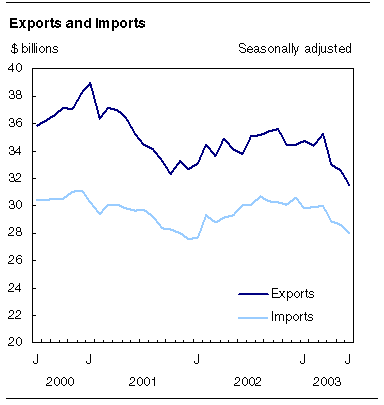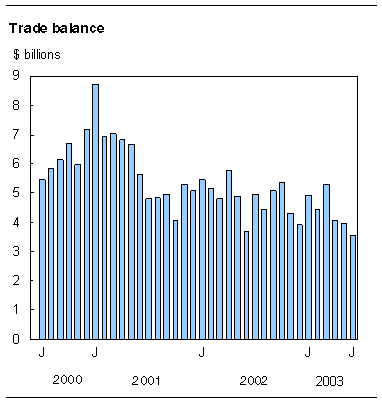
















 |
|
 |                |
Information identified as archived is provided for reference, research or recordkeeping purposes. It is not subject to the Government of Canada Web Standards and has not been altered or updated since it was archived. Please "contact us" to request a format other than those available.

|

Thursday, August 14, 2003 Canadian international merchandise tradeJune 2003Canada's merchandise trade balance fell for the third consecutive month to $3.6 billion, its lowest level since October 1999, as the 3.2% decline in exports outpaced the 2.2% drop in imports. Canadian exporters sent $31.6 billion of goods abroad in June, the lowest level since September 1999, as a result of weak aircraft, automotive and agricultural exports, and as 34 countries closed their borders to Canadian beef exports for the entire month. 
Total imports for June fell to $28.0 billion, their lowest level since January 2002, as all sectors, except energy and machinery and equipment, decreased or remained unchanged this month. Although exports to the United States dropped 1.6% in June to $26.5 billion, Canada's imports from there plunged 3.8%, resulting in a trade surplus increase with the United States to just under $7.2 billion. June was also a strong month for the Canadian dollar, which again appreciated against the US dollar and may have been a contributing factor in these declines. The trade deficit with all non-US principal trading partners widened in June, as exports to every major trading region except Japan fell. Exports to Japan increased 2.3% to $767 million, while imports soared 21.0% to just over a billion dollars. As a result, the trade deficit with Japan rose to $317 million, more than double the level recorded in May ($146 million).
The largest export drops to principal trading areas occurred with the European Union, falling 12.2% to $1.8 billion, and the "all other countries" category, down 17.2% to $1.5 billion. Imports from the European Union fell 1.0% to $2.9 billion, while imports from other OECD countries rose 2.2% to $1.7 billion. 
Sluggish transportation industries and foreign border closures to Canadian beef topple exportsCanada's largest export sector, machinery and equipment, dropped 4.9% (-$374 million) from May. A 19.8% decrease in exports of aircraft, engines and parts was responsible for 83% of this decline, as the airline industry still struggles with lower passenger traffic. As a result, smaller aircraft are being sold abroad and the large hit this month erased the three previous modest monthly increases. The automotive product sector lost more ground, as exports decreased 2.6% in June. After a negligible increase last month, this sector resumed its slide that began in February. There were widespread declines within this sector: passenger autos fell $83.5 million (-2.2%), trucks and other motor vehicles dropped $75 million (-5.5%) and motor vehicle parts were down $34 million (-1.5%). Purchase incentives still remained, as domestic and foreign auto producers continued to compete for market share. Exports of agricultural products slipped 6.4% to $2.2 billion in June. On May 20, a single cow infected with bovine spongiform encephalopathy (BSE) led the United States, Japan and 32 other countries to close their borders to Canadian beef exports. Live bovine and bovine meat exports, which averaged $310 million a month on a customs basis prior to May, declined to about $2 million in June. With beef exports virtually ceasing, meat and meat preparations (which includes pork, poultry and veal) sank 22.3% to just under $250 million. June's decline followed the 22.0% loss in May, when the ban was implemented. All remaining export sectors experienced declines in June. The largest of these was a 2.6% drop in industrial goods and materials to $5.3 billion, the third consecutive monthly decrease. Forestry product exports fell 4.6% in June. A wood fibre shortage in Eastern Canada resulted in a 19.4% decline in wood pulp to $448 million, as less logging and wood processing occurred. A 6.5% decrease in other paper and paperboard also contributed to this decline. Energy products registered a decline of 0.8% in June, as a $142 million drop in crude petroleum, mainly price oriented and a setback in electricity exports overshadowed increases in natural gas and petroleum and coal products. Moderate temperatures in the United States combined with lower prices encouraged wholesalers to build inventories throughout the month. Import gains for energy and machinery and equipment fail to offset declines in other sectorsMonthly drops for all three automotive sub-sectors, ranging from 4.6% for trucks and other motor vehicles to 8.6% for passenger autos, drove the entire sector down 6.1% to $6.3 billion. This is almost $1.0 billion lower than the record $7.2 billion reached in December 2002. With an abundance of automobile supply and lowered prices to accompany other purchase incentives, automobile manufacturers are challenged to increase sales and fewer parts are therefore being imported to produce complete vehicles. Industrial goods and materials also suffered in June, as imports fell 5.0% to $5.3 billion. Just under half of this decline came from a 10.0% drop in metal and metal ores, while chemicals and plastics absorbed most of the rest, falling $111 million (-5.2%) in June. Imports of other consumer goods slipped 2.5% in June, as all sub-sectors fell except footwear, printed matter and miscellaneous end products. This brings imports of consumer goods to $3.8 billion after dropping $96.5 million in June. Agricultural and fishing products fell 2.0%, as imports of fruit and vegetables dropped 7.4% to $470 million. Lower prices and the availability of locally grown products exerted some downward pressure on this sector. All other import sectors declined, except energy products, machinery and equipment and forestry products. Energy products rose 4.6%, as decreases in other energy product imports failed to offset a strong 16.1% improvement in crude petroleum imports. The two previous sluggish months for this commodity have pulled this import sector down from its record level in March. On the strength of aircraft, engines and parts, of turbines and motors and of drilling and mining machinery, Canada's largest import sector, machinery and equipment increased by 1.5% in June. Available on CANSIM: tables 226-0001, 226-0002, 227-0001, 227-0002, 228-0001 to 228-0003 and 228-0033 to 228-0040. Definitions, data sources and methods: survey numbers, including related surveys, 2201, 2202 and 2203. The June 2003 issue of Canadian international merchandise trade (65-001-XIB, $14/$141) will be available soon. The publication will include tables by commodity and country on a customs basis. Current account data (which incorporate merchandise trade statistics, service transactions, investment income and transfers) are available quarterly in Canada's balance of international payments (67-001-XIB, $29/$93; 67-001-XPB, $38/$124). Merchandise trade data are available in PDF format on the morning of release. For more information on the publications, contact Jocelyne Elibani, (1-800-294-5583; 613-951-9647). To enquire about the concepts, methods or data quality of this release, contact Daryl Keen (613-951-1810), International Trade Division.
| |||||||||||||||||||||||||||||||||||||||||||||||||||||||||||||||||||||||||||||||||||||||||||||||||||||||||||||||||||||||||||||||||||||||||||||||||||||||||||||||||||||||||||||||||||||||||||||||||||||||||||||||||||||||||||||||||||||||||||||||||||||||||||||||||||||||||||||||||||||||||||||||||||||||||||||||||||||||||||||||||||||||||||||||||||||||||||||||||||||||||||||||||||||||||||||||||||||||||
|
|
|